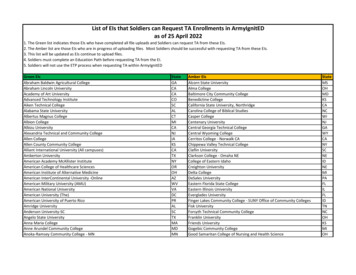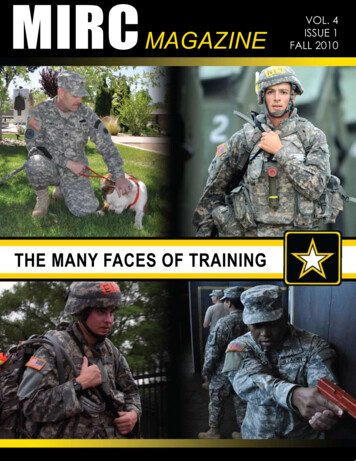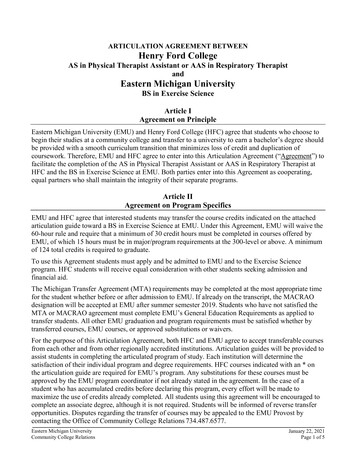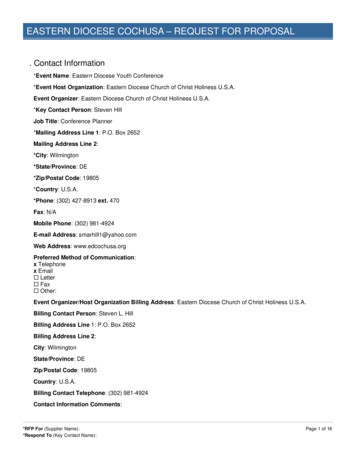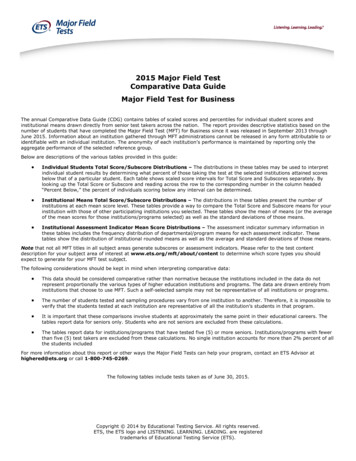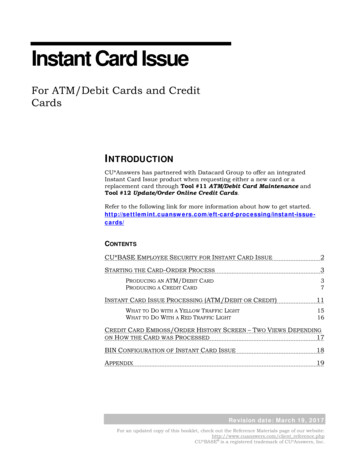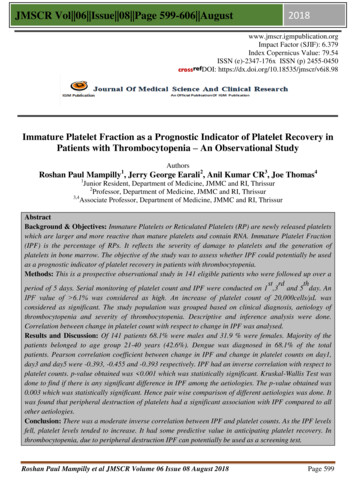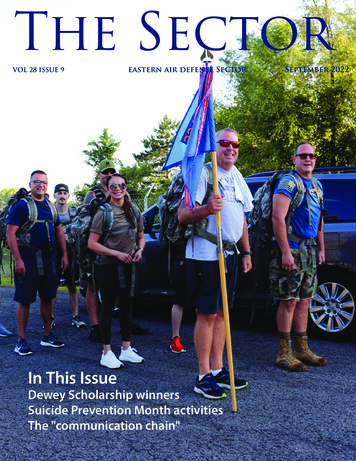
Transcription
The SectorVOL 28 ISSUE 9In This Issueeastern air defense SectorDewey Scholarship winnersSuicide Prevention Month activitiesThe "communication chain"September 2022
2Commander's CommentaryImproving the "communication chain"September 2022THE SECTORGreetings everyone! It’s hard to believe summer is wrapping up and we are alreadyinto September.At last month’s Commander’s Call we discussed communication, and the importanceof it within an organization. I wanted to follow up that discussion with some moredetail.Several years ago the National Academy of Sciences held a workshop to identify“Strategies to Enhance Communication with Internal and External Audiences.”Specifically looking at internal communication, workshop participants highlighted“that everyone in an organization, including leadership at every level, has a role ineffective communication.” Of note, they recognized that “often in organizations,the most important and effective person in the communication chain (ideally, thechain of command) whom employees look to for information and leadership is theirimmediate supervisor.” The workshop also noted that “immediate supervisors shouldhelp Airmen ‘connect the dots’.”Col. Joseph RoosFor everyone who is a supervisor, please realize that being part of the “communication chain” is a core functionof supervising. We need everyone to help ensure that information and intent are flowing both up and down the“communication chain.”September is Suicide Prevention Month and our prevention team has several events scheduled to highlight preventiontools and demonstrate how we are all connected. We will also pause this month to remember and reflect on the 21stanniversary of the 9/11 attacks. The suicide prevention team has planned a thoughtful event to recognize both thesignificance of the 9/11 attacks and the ways in which we have each other’s backs 24/7/365. Please consider taking partin the Sentinel Walk on the morning of the 10th and volunteering for part of the Sentinel Watch at the 9/11 MemorialTree. Additional details are on page 3.Remember, if you are feeling overwhelmed, alone, or helpless please reach out and talk to someone. The DPH,Chaplain, Shirt, your supervisor, a Commander, Chief, Military OneSource, etc. are all available and willing to lendan ear. #GotMySixStay safe, stay connected and stay steadfast in you dedication to the success of our mission!RoosterReference: National Academies of Sciences, Engineering, and Medicine. 2016. Strategies to Enhance Air Force Communicationwith Internal and External Audiences: A Workshop Report. Washington, DC: The National Academies Press. https://doi.org/10.17226/21876.On the cover: Col. Paul Bishop, right, Senior Master Sgt. Mark McAffee, 2nd from right, and Chief Master Sgt.Natasha VanDeusen, 224th Support Squadron Senior Enlisted Leader, 3rd from right, led Airmen on a ruckmarchduring the Regular Scheduled Drill on Aug. 6. The ruck march was part of the Dewey Gate-to-Gate event, which alsoincluded a run, a bike ride and scholarship presentations. Photo by Alicia Morales, 224th ADG Unit Program Coordinator.
THE SECTORNational Suicide Prevention MonthSeptember 2022#GotMySix, Sentinel March & Sentinel Watchhighlight Suicide Prevention Month3by Karen Silcott, 224th ADG Director of Psychological Health#GotmysixCheck out your local bulletin board for the return of #gotmysix. This activity focuses ongratitude and shout outs. Is there someone in the unit who has had your back over the past year?Want to give them a shout out? Post your feedback to the board. Cards provided. You can alsoe-mail 224th ADG Director of Psychological Health Karen Silcott at karen.silcott@us.af.mil andshe will post for you. Shout outs will also be posted on the closed-circuit TV system over themonth.Sentinel March on Sept. 10Join us on Sept. 10 at 0700 for an early morning walk and reflection about resiliency as we look after ourselves and payour respects to those lost to suicide. The March will take a three-mile route through Griffiss Business and TechnologyPark. It will start and end at the Survivor TreeSentinel Watch on Sept. 10 and 11The unit’s Suicide Prevention Team is hosting a Sentinel Watch over EADS on Sept. 10 and 11.The Sentinel Watch takes place at the 9/11 Memorial/Surivor Tree – it starts at the completion of theSentinel March -- and is composed of 25 onehour shifts. Two Airmen (you and your wingman)will sit at the memorial bench for an hour at time,demonstrating how unit members are there for eachother 24/7/365.The shifts start at 0900 on Saturday, Sept. 10 and endat 1028 on Sunday, Sept. 11 – 1028 is the time that theWorld Trade Center North Tower collapsed on Sept.11, 2001.All members, military and civilian, are encouraged to participate and families are welcome. Sign-up sheets areavailable on Teams at 224th ADG All/General/Files/11Sept Sentry Schedule.xlsx and on SharePoint at https://usaf.dps.mil/teams/224thADGAll/ layouts/15/Doc.aspx?OR teams&action edit&sourcedoc {F009D134-6F4C-4726BC22-1E5136F162F3}For more information, contact Staff Sgt. Alexandra Tracy via e-mail at alexandra.tracy@us.af.mil or 224th ADG DPHKaren Silcott at karen.silcott@us.af.mil or by phone at 334-6809. Staff Sgt. Tracy also provided information for this article.Suicide Prevention Training (Tier 1 & Tier II) sign-ups are also available on Teams. Knock your training out! Wewill also have special walkabout giveaways and raffle off some BioMetric lock boxes over the next month.
4September 2022Inspector GeneralMajor Graded Area refresher: Area 3THE SECTORby Lt. Col. Michael Kidd, 224th ADG Inspector GeneralContinuing the Inspector General series on the four Major Graded Areas (MGAs) of AFIS, this month’s topic, MGA3, focuses on improving the unit. As a refresher, the four MGAs (Managing Resources, Leading People, Improvingthe Unit, and Executing the Mission, see Fig.1, MGAs) represent key processes, procedures, and requirements basedon public law, executive orders, directives, and instructions and are identified in AFI 90-201. These imperatives, bydesign, coincide with a commander’s responsibilities as mandated in AFI 1-2, Commander’s Responsibilities, and,as the label implies, are the major areas for which a commander will be held accountable during a Unit EffectivenessInspection (UEI). Since commanders have the legal authority and responsibility to inspect their units, the IG officeserves, in part, to oversee the Commander’s Inspection Program (CCIP) and the unit’s Self-Assessment Program(SAP). Remember, the purpose of inspecting is to improve and evaluate the state of conformance, discipline, economy,efficiency, readiness, and resource management. Your individual role in this process is to focus on mission readinessevery day and to contribute to a culture of discipline and compliance with directives and Air Force Instructions.Figure 1. MGAsIt is worthwhile to remind unit members that the IG office exists, in part, to maintain an honest and accurate CCIP,validate self-assessment programs, assess unit effectiveness, and identify undetected non-compliance in high risk areas.Note that the IG office is not responsible for unit compliance, unit training, or fixing discrepancies/deficiencies.Improving the unit and its sub-areasAFI 1-2, paragraph 3.4 emphasizes continuous process improvement as a hallmark of highly successful organizations. Establishing a system of continuous process improvement is a commander’s responsibility for improving theunit. Wasteful, ineffective or unsafe ways of doing business cannot be tolerated. Furthermore, commanders must fostera culture of innovation and challenge inefficiencies. A process for identifying and fixing deficiencies should be estab-continued on next page
Inspector GeneralTHE SECTORMGA 3.continued from previous pageSeptember 20225lished and followed. Commanders must make data-driven decisions and manage risk while ensuring their unit’s authorities, missions, plans and goals stay strategically aligned. A robust self-assessment program will identify the root causeof deficiencies and enable sharing of best practices with other organizations. Commanders are also expected to inspecttheir units and subordinates to ensure maximum effectiveness, efficiency, economy and discipline of the force are maintained. Commanders should strive to leave their unit better than they found it.AFI 1-2: paragraph 3.4.1. Strategic Alignment. Commanders must strive for strategic alignment within theirorganizations. This includes aligning authorities with mission requirements. Vision and mission statements should leadto strategic plans that include yearly calendars and annual budgets. Performance metrics should also be establishedand monitored to enable data-driven decisions. In addition, metrics should be reviewed in light of updated missionrequirements to ensure the unit is measuring relevant mission outputs.AFI 1-2: paragraph 3.4.2. Process Operations. Leaders must be aware of critical processes, and constantly seek to improve and standardize those processes to produce more reliable results. Remove any bottle-necks or limiting factors andensure risk management principles are applied during daily operations. All risks, including safety and risks to personnel, should be considered when analyzing and improving processes.AFI 1-2: paragraph 3.4.3. Commander’s Inspection Program. Commanders have the legal authority and responsibility to inspect their subordinates and subordinate units. A robust commander’s inspection program finds deficiencies andimproves mission readiness. Part of this effort must be a self-assessment program where individual Airmen report theircompliance with guidance. An independent verification of those reports provides commanders with additional confidence in their validity. The findings from self-assessments and inspections should drive a root-cause analysis whichfeeds back into the processes described in paragraph 3.4.1.AFI 1-2: paragraph 3.4.4. Data-Driven Decisions. Commanders are expected to make data-driven decisions. Whenconstraints do not allow, commanders may be forced to make decisions with limited data, and are expected to use experience, judgment and all available resources to guide them.References: AFI 1-2, Commander’s Responsibilities, 8 May 2014; AFI 90-201, The Air Force Inspection System, 20November 2018.THE SECTOREditorial StaffCol. Paul Bishop, Eastern Air Defense Sector CommanderCol. Joseph Roos, 224th ADG CommanderTim Jones, 224th ADG Community Relations ManagerMaj. Jason Gabrick, 224th ADSAlicia Morales, 224th ADG Unit Program CoordinatorThe Sector is an authorized publication for members of the U.S. military services. Contents of TheSector are not necessarily the official views of or endorsed by the U.S. Government, the Department ofDefense, the Department of the Air Force or the AirNational Guard. The editorial content is edited, prepared and provided by the Public Affairs Office ofthe Eastern Air Defense Sector. All photographs areAir Force photographs unless otherwise indicated.
6224th ADSTHE SECTOREADS members attend CBC2 Roadmap trainingSeptember 2022by Dr. Brian Tuttle, Chief of Capabilities and Requirements (DOM), 224th ADSDuring the first week of August, five EADS members—Lt. Col. Sam Abbe (Det. 1), Maj. Greg Elliott (serving a tour withAir Combat Command), Maj. Tyler De Santis, Master Sgt. Asa Peterson and Dr. Brian Tuttle—attended the Cloud-basedCommand and Control (CBC2) Roadmap event at the Howard Hughes Center in Las Vegas, Nevada. Formerly known as“Pathfinder,” CBC2 is the system in development to replace the Battle Control System-Fixed (BCS-F).As warfighter subject matter experts (SME), these five personnel joined other SMEs—including other warfighters, portfolio/integration specialists, engineers/technicians and testers—from several units to help the Rapid Capabilities Office (RCO)to refine the CBC2 Capability Needs Statement (CNS) in preparation for the development of Minimum Viable Product #4(MVP 4). MVP development eventually leads to the approval for a Minimum Viable Capabilities Release (MVCR). CBC2’sMVCR #5 arrival is scheduled in April 2023.If the reader is unfamiliar with the terms in the previous paragraphs, definitions are found in AFI 63-150/DoDI 5000.87Software Acquisition Pathway:More information about the Rapid Capabilities Office (RCO) is found at this link: ticle/2424302/rapid-capabilities-office/.In order to accomplish their goal, CBC2 Roadmap participants split up into several groups that focused on various areasof the CNS, especially their “epics” (i.e., “how we will realize the vision,” or “a group of stories that describe a high-levelcapability”). Maj. Elliott facilitated the Force Accountability group, and Maj. De Santis paired with a program management specialist to facilitate the Risk Assessment group. Although they also helped other groups, Lt. Col. Abbe and Dr. Tuttleworked primarily with the Risk Assessment group. Master Sgt. Peterson usually fit in with the Platform group (i.e., thoseconcerned with developing the cloud network, without which there would be no possibility of a cloud-based C2).Above left: Maj. Elliott facilitating the Force Accountability group. On the right: The Risk Assessment group at work withEADS members Maj. DeSantis and Lt. Col Abbe. Photos by Dr. Brian Tuttle, 224th ADS.continued on next page
THE SECTOR224th ADSSeptember 2022CBC2 roadmap.continued from previous page7Each group followed the same process to arrive at its ultimate product—updated epics and CNS for a specific area of CBC2development. Process steps had to be completed on a rigid timeline and, at the end of each day, each group provided a shortbrief of their activity to all participants. It began with a “deep dive” to examine the current state of the CNS’s large-scaleelements and revise them as needed to best capture what the warfighter does when executing the mission.Next each group created a “value-stream map” to show how the workflow moved through their focus area, which will influence system design. Traditionally, operator workflow has been based upon machine limitations: humans must “pick upthe slack” by working around BCS-F’s constraints, such as its stovepipe design. By contrast, CBC2’s value-stream-orienteddesign will optimize the human-machine team’s mission tasks so that machines allow warfighters to more rapidly extract theinformation needed for battlespace awareness and decision making.The last and largest step was to build an “opportunity tree” that identifies ways that the developers can create the highestvalue while coding CBC2’s MVP #4. Together, these three products will shape the revised epics/CNS and, in turn, the development of CBC2 over the next several months and beyond.With the new epics/CNS to guide them, the developers will employ “Agile DevOps.” This software development methodinvolves making incremental improvements to existing capabilities, so that the features providing the highest-vale are developed and fielded as quickly as possible. As shown in the figure below, the process is broken into “sprints”—short timeperiods (e.g., two weeks) during which the operators provide feedback on the current product, then coders implement newsoftware based upon that input. Once the operators are satisfied with the product, the developers will refer back to the Roadmap and identify the next MVP to create. Such development continues throughout the lifecycle of the product.Thus, the involvement of EADS operators in the Agile DevOps process is critical to developing this system so that itmeets their needs, and they in turn will be able to employ a C2 system that allows EADS to meet America’s national defenseneeds. If you would like to get involved in assisting with the development of CBC2, Maj. De Santis is looking for personnel to attend Hypergiant sprint events on Teams every Friday at 1400L (or view the replay) and comment on its currentfunctionality so that developers can tailor it to their needs.CBC2 is expected to achieve initial operating capability (IOC) by October 2023. That is, EADS will have a versionof CBC2 usable on the EADS operations floor as a reference tool. BCS-F will remain the primary system asdevelopers increase the capability of CBC2 until it surpasses that of legacy system. At that point, the Air Force willdeprecate BCS-F and CBC2 will become the new C2 system. Afterward, the Air Force will continue to make incrementalimprovements via Agile DevOps throughout CBC2’s life cycle. In short, the CBC2 system and the Agile DevOps methodwill revolutionize how we do business at EADS.
8Detachment 1Det 1 hosts JADOC Summer Bash 2022September 2022THE SECTORby Master Sgt. Stephanie Spradley, 224th ADG Detechment 1The Joint Air Defense Operations Center's Annual Summer Bash was fun to be had by all! Members of 224thADG Detachment 1, the Army Task Force and Battalion, JADOC Contractors, and their families came together forthis connectedness event. An Avenger static display, courtesy of the 2-263 Air Defense Artillery Battalion, broughtan operational feel to the summer fun.The aroma of food filled the air as Senior Master Sergeants Angel Aponte and Robert Schlubach grilledhamburgers and hotdogs. Along with the array of food available was Lt. Col. Josh Jessup’s downright deliciousbrisket (it didn’t take long for it to be completely devoured).In addition to the Avenger display, children were entertained with corn hole games and a bouncy house untilfamilies went inside for a sanitized Ops Floor tour. After the tour, it was back outside for snowballs handmade byMaster Sgt. Stephanie Spradley’s sons, Nathaniel and Gabriel.Recently retired Lt. Col. Vic Walk and Det 1 alumnus Lt. Col. Joe Simonetti also made an appearance.Master Sergeants Katie Miller, Stephanie Spradley, Melissa Sterpin, and Tech. Sgt. Ethan Dudden put the SummerBash together. CPT Campion, 1LT Johnson, SSG Price, SGT Garcia, SPCs Bright, Bowling, Booker, and Cannonof the 2-263 ADA Battalion provided event setup and teardown.Det 1 Airmen and family members enjoyed the Summer Bash 2022 connectivity event, held recently at the Joint AirDefense Operations Center. The Airmen was joined by their Army counterparts and contractors. Photo courtesy of Lt.Dan Steere, 22th ADG Det 1.
THE SECTORPromotions & AwardsSeptember 2022The 224th ADS promoted Staff Sgt. Alexandra Tracy and Senior Airman Megan Mills at an Aug.18 ceremony in the Building 703 auditorium. Lt. Col. Jennifer King, the 224th ADS Director ofOperations, was the promoting officer and is pictured on the left in the two photos.Staff Sgt. Alexandra Tracy9Senior Airman Megan MillsFour EADS Airmen receive Dewey ScholarshipsFor the sixth consecutive year, the Col. WadeF. Dewey Scholarship has provided EADSmembers and spouses with money for highereducation.Given in memory of the former 224th ADGCommander, the four 1,250 scholarships werepresented as part of the annual Dewey Gate toGate run on Aug. 6. Ms. Selena Dewey andMitchell Dewey presented the awards.This year's recipents were Master Sgt. ToddDavis, Tech. Sgt. Gary Gillespie, Staff Sgt.Lyhanna Usher and Mrs. Christi Stone.Master Sgt. Todd Davis, right, shakes hands with Ms.Selena Dewey at this year's Dewey Scholarship presentationon Aug. 6. Col. Dewey's son, Mitchell, is pictured on theleft. Tech. Sgt. Gary Gillespie, Staff Sgt. Lyhanna Usher andMrs. Christi Stone also received Dewey scholarships. Photoby Ms. Alicia Morales, 224th ADG Unit Program Coordinator.
10HistoryTHE SECTORBeyond the movies: The story of Top GunSeptember 2022by Staff Sgt. Andrew McNamara, 224th SPTS C2 Mission SystemsHaving seen both Top Gun films recently, and with a renewedsense of pride in my family’s naval heritage, I decided thisSeptember I would enlighten you with the origins of the USNavy Strike Fighter Tactics Instructor Program.Why was this program established? We must go back to the1960s, during the Vietnam War.During the air war, the Navy suffered horrendous losses inaircraft and pilots during Operation Rolling Thunder.An experienced WWII naval aviator, Navy Capt. Frank Aultled the charge to investigate the deadly trends, their causeand-effect, and how they could be remedied.The research, known as the Ault Report, traced severalfactors to blame. These included having an over-relianceon air-to-air missiles (some aircraft had no guns at all!),politically motivated rules of engagement that created anThe initial Top Gun class, 1969. Photo from https://www.usni.org/extreme danger for pilots, and most importantly, a lack s-first-centerexcellencetraining in how to dogfight with guns. Dogfighting hadbecome a lost art since the end of World War II and it did nothelp that while Navy pilots were given plenty of carrier and bombing run training, advanced fighter tactics were being neglected.With this in mind, the Top Gun program was created, although its official name would be the Navy Fighter Weapons School.With the new training received, the Navy quickly saw results with much higher kill-to-loss ratio against enemy North Vietnameseaircraft. These successes ensured that the Top Gun program had a bright future.Despite initially operating on a shoestring budget, Top Gun would later expand to include full aggressor squadrons. While otherNavy aircraft could serve this role, the program also utilized aircraft from the Constant Peg program, a now-declassified projectthat involved the use of actual MiG aircraft that had been obtained through various means, and operated by the USAF’s 4477thTraining and Evaluation Squadron.Following the Base Realignment and Closure wave of 1995, the program was moved from Naval Air Station Miramar in SanDiego, to NAS Fallon in Nevada, with the Marines utilizing the base as MCAS Miramar.It is worth noting that even today, pilots who are attending the training period are forbidden from making any references to the1986 film while they are on duty, and per tradition are fined 5 each time.The opportunity is extremely selective and less than 1 percent of Navy pilots will attend the 13-week program, now a part of theNaval Aviation Warfighting Development Center.Upon graduating, they return to their squadrons and carriers armed with their new knowledge to pass on to their peers, some willlater become instructors themselves, and they will have attained their place in the ranks of some of the most elite pilots in theworld.References and Helpful istory.html?chrome 1https://www.livescience.com/real-top-gun
THE SECTORHistory Around the World1971: India's daring interventionSeptember 202211by Staff Sgt. Andrew McNamara, 224th SPTS C2 Mission SystemsIn 1947, British India was partitioned into two nations, India and Pakistan.This was designed to address both religious and cultural differences betweenethnic groups who inhabited these lands of the former Crown Colony.Pakistan was further divided into east and west. West Pakistan possessedabsolute power, while East Pakistan, with its much higher population of ethnicBengalis, was oppressed and had little or no representation in the nation'sgovernance.With calls for independence growing, Pakistan’s military cracked down onthe Bengalis with Operation Searchlight, committing atrocities that resultedin a genocide that killed somewhere between 500,000 to 3 million people,according to estimates.Indian Army Chief-of-Staff, Sam Manekshaw, center,was famous for his "surrennder or we wipe you out"message to the East Pakistan Army. Photo fromhttps://www.dnaindia.com.With India’s people demanding intervention, Prime Minister Indira Gandhiopenly declared Indian support for Bengali independence, denounced the atrocities, and began exploring the option of war withPakistan. These efforts were hindered by the monsoon season and the Indian Army’s report that more time was needed to serviceits tank forces.With this new intelligence, Pakistan’s air force attacked first, bombing several Indian airfields in a preemptive strike. Respondingquickly, India launched retaliatory strikes against Pakistani airfields. Consisting of mostly British and Russian-built aircraft,India’s air force quickly established air superiority.At sea, the Indian Navy, which had inherited a large number of British ships at independence, launched Operations Trident andPython to cripple Pakistan’s ability to supply her military. The Indian navy destroyed the oil storage tanks in the port of Karachiand the Indian aircraft carrier INS Vikrant launched sorties against the port of Chittagong in the east, where Pakistan had fewnaval assets. With support from several other vessels, the Indian navy sealed off Chittagong, and the entire Bay of Bengal to WestPakistan, denying any reinforcement.Being divided in two proved to be the Pakistani military’s undoing. Ground forces in East Pakistan were now cut off, could not bereinforced, and they had to contend with both the Indian Army and Bengali resistance fighters, the Mukti Bahini. After a seriesof bloody land battles, East Pakistan’s Army was broken, over 90,000 soldiers surrendered and hostilities ended in Dhaka on Dec.16, 1971.In just 13 days India had emerged victorious, thanks largely to the outstanding interoperability of her air, land, and naval forces.Pakistan, however, was humiliated, losing half its territory while taking huge losses in men and material. Tragically, the outcomeof the 1971 War established motives for Pakistan’s support of terrorist groups as a weapon against India even today, especially inthe Jammu-Kashmir Conflict.With East Pakistan’s dissolution, over 75 million people would become a new nation: ws/indian-navyReferences and Helpful rs/PattonNagar/1971/
12SafetyTHE SECTORAdjust chairs to reduce aches and painsSeptember 2022by Mr. Colt Brumm, 224th ADG Occupational Safety and Health ManagerYes, you are allowed to fiddle with your chairWe spend a LOT of time in our chairs at work. Like, so much time.While that whole “sitting is the new smoking” thing may or may notbe true, there is no doubt that sitting in a BAD chair can cause allsorts of aches and pains.Many complaints of back, neck, and shoulder pain and chronicheadaches can be addressed by applying ergonomics to the workarea. Just as you wouldn’t want to run a marathon in the wrong sizeshoes, you shouldn’t spend 30-40 hours a week in a chair that doesn’tfit.We can’t order each person their own personal chair, so instead wehave adjustable chairs. At any workstation you can make a few smalladjustments and have a chair that is at least pretty good.The catch: you have to be willing to make those adjustments. Pressthe buttons! Flip the levers! Jiggle the handles! Not only is it OK, butit is highly encouraged.image from Canadian Centre for Health and Safety(ccohs.ca)To properly fit an office chair (note: not all chairs have all of these adjustments):1. Sit upright with your feet flat on the floor.2. Raise/lower the seat until the top of your thighs are parallel to the ground.3. Slide the seat pan (the part you sit on) forward or back until you can just fit 3-4 finger widths between the back ofyour calf and the front edge of the seat.4. Move the back rest height or lumbar support until the curve of the seat back aligns with the natural curve of yourspine.5. Move the armrests in or out until they are comfortably close to your side.6. Let your upper arms hang loosely by your side with your elbows bent at 90 degrees and your lower arms forward.Raise or lower the armrests until they provide light support to your arms.7. The headrest should allow your head to remain comfortably aligned with your upper body. It should not feel likeit is pushing your head forward or downward.8. The seat tilt angle (generally 115 to 135 degrees), tilt tension, armrest angle, and armrest forward/back adjustmentare generally matters of personal preference. Fiddle with them until you find the right fit for your body’s uniquestructure.9. Now that the chair is “neutral”, personalize the fit to your body. Maybe you like your arms a little higher or yourseat a little lower. Go for it! The neutral posture is more of a good, systematic starting-off point than it is the“right way.” Just make sure your body remains supported and that you don’t induce twisting, bending, or imbalances.You may find that at different times and dates you have
For more information, contact Staff Sgt. Alexandra Tracy via e-mail at alexandra.tracy@us.af.mil or 224th ADG DPH Karen Silcott at karen.silcott@us.af.mil or by phone at 334-6809. Staff Sgt. Tracy also provided information for this article. Suicide Prevention Training (Tier 1 & Tier II) sign-ups are also available on Teams. Knock your training .
